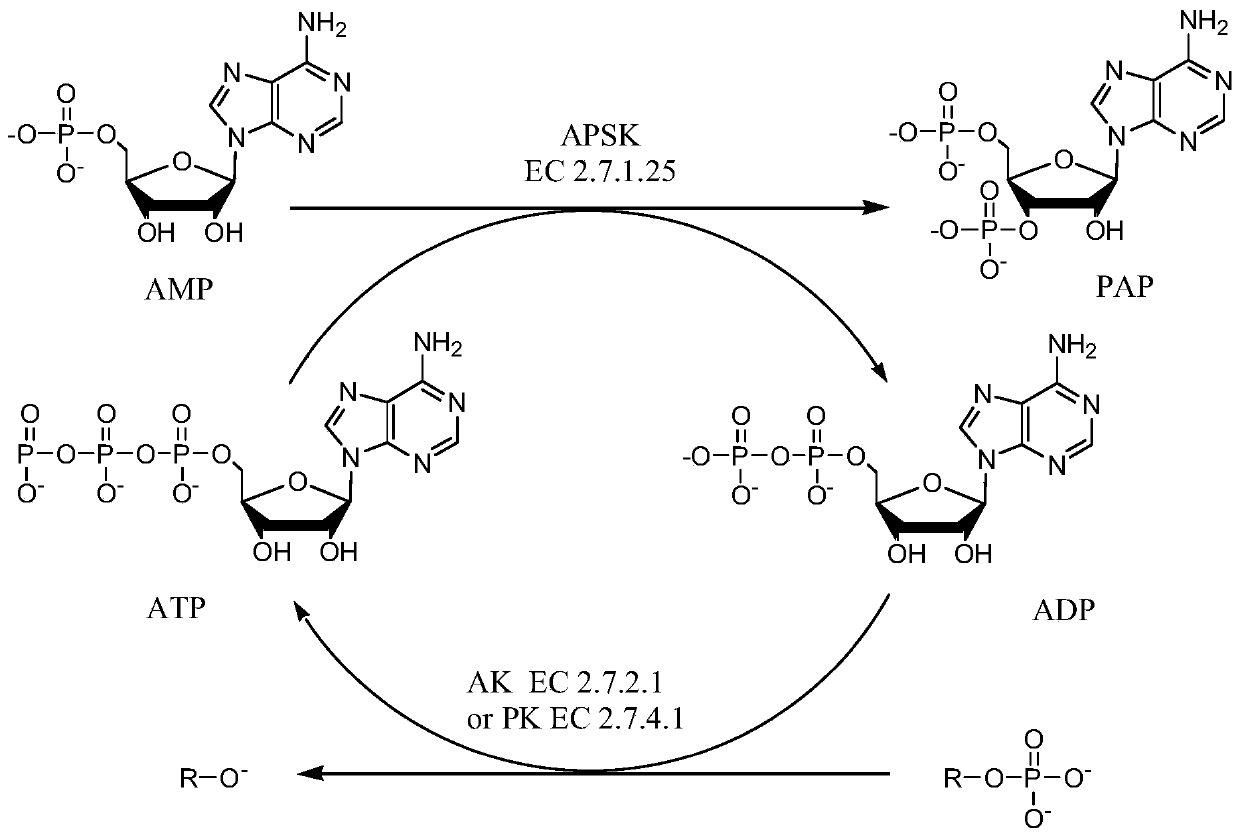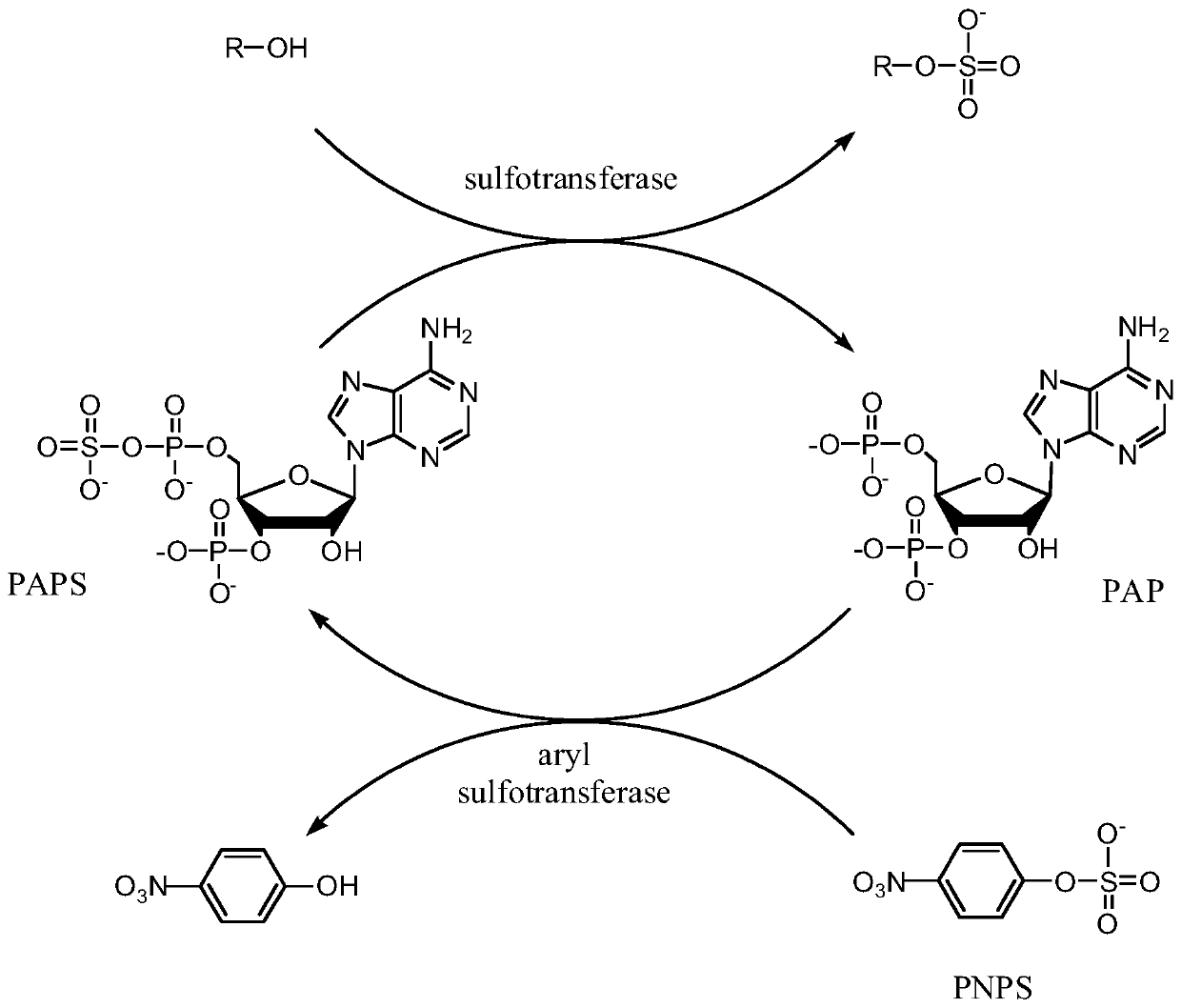Enzymatic synthesis method and application of 3',5'-adenosine diphosphate (PAP)
A kind of technology of adenosine diphosphate and synthesis method, which is applied in the direction of biochemical equipment and methods, enzymes, transferases, etc., to achieve the effect of low price, excellent stability, and reduced enzyme cost
- Summary
- Abstract
- Description
- Claims
- Application Information
AI Technical Summary
Problems solved by technology
Method used
Image
Examples
Embodiment 1
[0028] (1) Construction and fermentation expression of 5'-phosphosulfatase kinase (SEQ01) and acetate kinase (SEQ06) co-expression bacteria
[0029] The APSK with the amino acid sequence of SEQ01 and the AK with the amino acid sequence of SEQ06 were respectively optimized for Escherichia coli codons to construct the pETDuet-SEQ01-SEQ06 expression vector, and the constructed and verified correct expression vector was heat-shock transformed Escherichia coli BL21 (DE3) , after the transformation is completed, smear a plate containing AMP, pick a single clone to express, and measure the enzyme activity verification; amplify the strain with better expression and save the seed bank seeds; take a seed bank seed to amplify, inoculate the fermenter for fermentation, When the OD reaches 22-40, cool down to 28-30°C, add IPTG with a final concentration of 0.6mM to induce, continue to feed the culture for no less than 8 hours, put the tank, and collect the wet cells by centrifugation, which...
Embodiment 2
[0037] (1) Construction and fermentation expression of 5'-phosphosulfatase kinase (SEQ01) and acetate kinase (SEQ06) individual expression bacteria
[0038] The APSK with the amino acid sequence of SEQ01 and the AK with the amino acid sequence of SEQ06 were codon-optimized in Escherichia coli to construct pET22b-SEQ01 and pET22b-SEQ06 expression vectors respectively, and the constructed and verified correct expression vectors were transformed into Escherichia coli by heat shock BL21(DE3), after the transformation is completed, spread the plate containing Amp, pick a single clone to express, measure the enzyme activity verification; amplify the strain with better expression and save the seed bank seeds; take a seed bank seed to amplify and inoculate Ferment in a fermenter, cool down to 28-30°C when the OD reaches 22-40, add IPTG at a final concentration of 0.6mM to induce, continue to feed the culture for no less than 10 hours, put the tank, and collect the wet cells by centrifu...
Embodiment 3
[0046] (1) Construction and fermentation expression of 5'-phosphosulfatase kinase (SEQ02) and acetate kinase (SEQ07) individual expression bacteria
[0047] The APSK with the amino acid sequence of SEQ02 and the AK with the amino acid sequence of SEQ07 were codon-optimized in Escherichia coli respectively, and the pET28a-SEQ02 and pET28a-SEQ07 expression vectors were respectively constructed, and the constructed and verified correct expression vectors were heat-shocked and transformed into Escherichia coli For BL21(DE3), after the transformation is completed, apply a Kan-containing plate, pick a single clone for expression, and measure the enzyme activity for verification; perform the expression of the two enzymes and the storage of the bacteria according to the procedures in 1 in Example 1;
[0048] (2) crude enzyme extraction
[0049] Using the method of step (2) in Example 1 to carry out the extraction and preservation of 5'-phosphosulfatase kinase (SEQ02) and acetate kinas...
PUM
 Login to View More
Login to View More Abstract
Description
Claims
Application Information
 Login to View More
Login to View More - R&D
- Intellectual Property
- Life Sciences
- Materials
- Tech Scout
- Unparalleled Data Quality
- Higher Quality Content
- 60% Fewer Hallucinations
Browse by: Latest US Patents, China's latest patents, Technical Efficacy Thesaurus, Application Domain, Technology Topic, Popular Technical Reports.
© 2025 PatSnap. All rights reserved.Legal|Privacy policy|Modern Slavery Act Transparency Statement|Sitemap|About US| Contact US: help@patsnap.com



